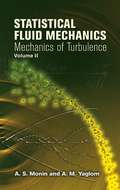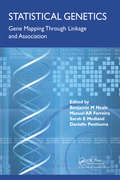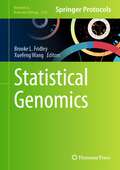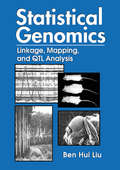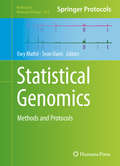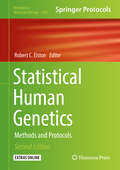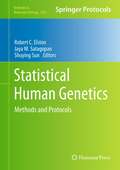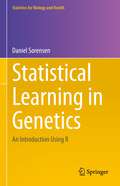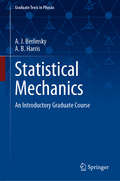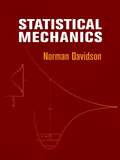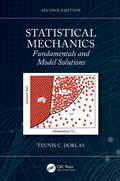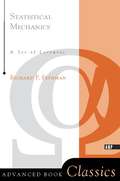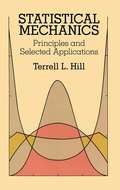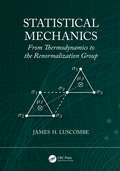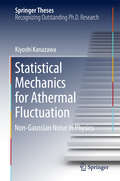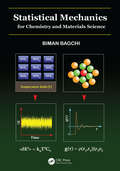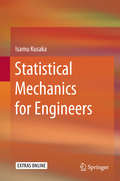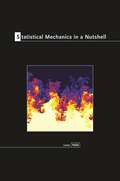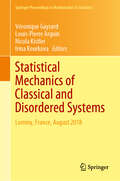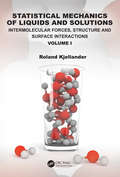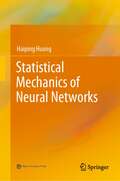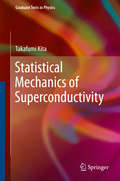- Table View
- List View
Statistical Fluid Mechanics, Volume II: Mechanics of Turbulence (Dover Books on Physics #2)
by A. S. Monin A. M. YaglomWritten by two of Russia's most eminent and productive scientists in turbulence, oceanography, and atmospheric physics, this two-volume survey is renowned for its clarity as well as its comprehensive treatment. The first volume begins with an outline of laminar and turbulent flow. The remainder of the book treats a variety of aspects of turbulence: its statistical and Lagrangian descriptions, shear flows near surfaces and free turbulence, the behavior of thermally stratified media, and diffusion.Volume Two continues and concludes the presentation. Topics include spectral functions, homogeneous fields, isotropic random fields, isotropic turbulence, self-preservation hypotheses, spectral energy transfer, the Millionshchikov hypothesis, acceleration fields, equations for higher moments and the closure problem, and turbulence in a compressible fluid. Additional subjects include general concepts of the local structure of turbulence at high Reynolds numbers, the theory of fully developed turbulence, the propagation of electromagnetic and acoustic waves through a turbulent medium, and the twinkling of stars. The book closes with a discussion of the functional formulation of the problem of turbulence, presenting the equations for the characteristic functional and methods for their solution.
Statistical Genetics: Gene Mapping Through Linkage and Association
by Benjamin M Neale Manuel Ar Ferreira Sarah E Medland Danielle PosthumaStatistical Genetics is an advanced textbook focusing on conducting genome-wide linkage and association analysis in order to identify the genes responsible for complex behaviors and diseases. Starting with an introductory section on statistics and quantitative genetics, it covers both established and new methodologies, providing the genetic and statistical theory on which they are based. Each chapter is written by leading researchers, who give the reader the benefit of their experience with worked examples, study design, and sources of error.The text can be used in conjunction with an associated website (www.genemapping.org) that provides supplementary material and links to downloadable software.
Statistical Genomics (Methods in Molecular Biology #2629)
by Brooke L. Fridley Xuefeng WangThis volume provides a collection of protocols from researchers in the statistical genomics field. Chapters focus on integrating genomics with other “omics” data, such as transcriptomics, epigenomics, proteomics, metabolomics, and metagenomics. Written in the highly successful Methods in Molecular Biology series format, chapters include introductions to their respective topics, lists of the necessary materials and reagents, step-by-step, readily reproducible laboratory protocols, and tips on troubleshooting and avoiding known pitfalls. Cutting-edge and thorough, Statistical Genomics hopes that by covering these diverse and timely topics researchers are provided insights into future directions and priorities of pan-omics and the precision medicine era.
Statistical Genomics: Linkage, Mapping, and QTL Analysis
by Ben Hui LiuGenomics, the mapping of the entire genetic complement of an organism, is the new frontier in biology. This handbook on the statistical issues of genomics covers current methods and the tried-and-true classical approaches.
Statistical Genomics
by Ewy Mathé Sean DavisThis volume expands on statisticalanalysis of genomic data by discussing cross-cutting groundwork material,public data repositories, common applications, and representative tools foroperating on genomic data. Statistical Genomics: Methods andProtocols is divided into four sections. The first section discussesoverview material and resources that can be applied across topics mentionedthroughout the book. The second section covers prominent public repositoriesfor genomic data. The third section presents several different biologicalapplications of statistical genomics, and the fourth section highlightssoftware tools that can be used to facilitate ad-hoc analysis and dataintegration. Written in the highly successful Methods in MolecularBiology series format, chapters include introductions to theirrespective topics, step-by-step, readily reproducible analysis protocols, andtips on troubleshooting and avoiding known pitfalls. Through and practical, StatisticalGenomics: Methods and Protocols, explores a range of both applicationsand tools and is ideal for anyone interested in the statistical analysis ofgenomic data.
Statistical Human Genetics: Methods and Protocols (Methods in Molecular Biology #1666)
by Robert C. ElstonRecent advances in genetics over the last quarter of a century, especially in molecular techniques, have dramatically reduced the cost of determining genetic markers and hence opened up a field of research that is increasingly helping to detect, prevent and/or cure many diseases that afflict humans. In Statistical Human Genetics: Methods and Protocols expert researchers in the field describe statistical methods and computer programs in the detail necessary to make them more easily accessible to the beginner analyzing data. Written in the highly successful Methods in Molecular Biology(tm) series format, with examples of running the programs and interpreting the program outputs, the chapters include the kind of detailed description and implementation advice that is crucial for getting optimal results from human genetic data collected in the laboratory. Thorough and as much as possible intuitive, Statistical Human Genetics: Methods and Protocols aids scientists in understanding the computer programs and analytical procedures they need to use.
Statistical Human Genetics
by Robert C. Elston Shuying Sun Jaya M. SatagopanRecent advances in genetics over the last quarter of a century, especially in molecular techniques, have dramatically reduced the cost of determining genetic markers and hence opened up a field of research that is increasingly helping to detect, prevent and/or cure many diseases that afflict humans. In Statistical Human Genetics: Methods and Protocols expert researchers in the field describe statistical methods and computer programs in the detail necessary to make them more easily accessible to the beginner analyzing data. Written in the highly successful Methods in Molecular BiologyTM series format, with examples of running the programs and interpreting the program outputs, the chapters include the kind of detailed description and implementation advice that is crucial for getting optimal results from human genetic data collected in the laboratory. Thorough and as much as possible intuitive, Statistical Human Genetics: Methods and Protocols aids scientists in understanding the computer programs and analytical procedures they need to use.
Statistical Learning for Biomedical Data
by James D. Malley Karen G. Malley Sinisa PajevicThis book is for anyone who has biomedical data and needs to identify variables that predict an outcome, for two-group outcomes such as tumor/not-tumor, survival/death, or response from treatment. Statistical learning machines are ideally suited to these types of prediction problems, especially if the variables being studied may not meet the assumptions of traditional techniques. Learning machines come from the world of probability and computer science but are not yet widely used in biomedical research. This introduction brings learning machine techniques to the biomedical world in an accessible way, explaining the underlying principles in nontechnical language and using extensive examples and figures. The authors connect these new methods to familiar techniques by showing how to use the learning machine models to generate smaller, more easily interpretable traditional models. Coverage includes single decision trees, multiple-tree techniques such as Random Forests(TM), neural nets, support vector machines, nearest neighbors and boosting.
Statistical Learning in Genetics: An Introduction Using R (Statistics for Biology and Health)
by Daniel SorensenThis book provides an introduction to computer-based methods for the analysis of genomic data. Breakthroughs in molecular and computational biology have contributed to the emergence of vast data sets, where millions of genetic markers for each individual are coupled with medical records, generating an unparalleled resource for linking human genetic variation to human biology and disease. Similar developments have taken place in animal and plant breeding, where genetic marker information is combined with production traits. An important task for the statistical geneticist is to adapt, construct and implement models that can extract information from these large-scale data. An initial step is to understand the methodology that underlies the probability models and to learn the modern computer-intensive methods required for fitting these models. The objective of this book, suitable for readers who wish to develop analytic skills to perform genomic research, is to provide guidance to take this first step.This book is addressed to numerate biologists who typically lack the formal mathematical background of the professional statistician. For this reason, considerably more detail in explanations and derivations is offered. It is written in a concise style and examples are used profusely. A large proportion of the examples involve programming with the open-source package R. The R code needed to solve the exercises is provided. The MarkDown interface allows the students to implement the code on their own computer, contributing to a better understanding of the underlying theory.Part I presents methods of inference based on likelihood and Bayesian methods, including computational techniques for fitting likelihood and Bayesian models. Part II discusses prediction for continuous and binary data using both frequentist and Bayesian approaches. Some of the models used for prediction are also used for gene discovery. The challenge is to find promising genes without incurring a large proportion of false positive results. Therefore, Part II includes a detour on False Discovery Rate assuming frequentist and Bayesian perspectives. The last chapter of Part II provides an overview of a selected number of non-parametric methods. Part III consists of exercises and their solutions.Daniel Sorensen holds PhD and DSc degrees from the University of Edinburgh and is an elected Fellow of the American Statistical Association. He was professor of Statistical Genetics at Aarhus University where, at present, he is professor emeritus.
Statistical Mechanics: An Introductory Graduate Course (Graduate Texts in Physics)
by A. J. Berlinsky A. B. HarrisIn a comprehensive treatment of Statistical Mechanics from thermodynamics through the renormalization group, this book serves as the core text for a full-year graduate course in statistical mechanics at either the Masters or Ph.D. level. Each chapter contains numerous exercises, and several chapters treat special topics which can be used as the basis for student projects. The concept of scaling is introduced early and used extensively throughout the text. At the heart of the book is an extensive treatment of mean field theory, from the simplest decoupling approach, through the density matrix formalism, to self-consistent classical and quantum field theory as well as exact solutions on the Cayley tree. Proceeding beyond mean field theory, the book discusses exact mappings involving Potts models, percolation, self-avoiding walks and quenched randomness, connecting various athermal and thermal models. Computational methods such as series expansions and Monte Carlo simulations are discussed, along with exact solutions to the 1D quantum and 2D classical Ising models. The renormalization group formalism is developed, starting from real-space RG and proceeding through a detailed treatment of Wilson’s epsilon expansion. Finally the subject of Kosterlitz-Thouless systems is introduced from a historical perspective and then treated by methods due to Anderson, Kosterlitz, Thouless and Young. Altogether, this comprehensive, up-to-date, and engaging text offers an ideal package for advanced undergraduate or graduate courses or for use in self study.
Statistical Mechanics
by Norman DavidsonClear and readable, this fine text assists students in achieving a grasp of the techniques and limitations of statistical mechanics. The treatment follows a logical progression from elementary to advanced theories, with careful attention to detail and mathematical development, and is sufficiently rigorous for introductory or intermediate graduate courses.Beginning with a study of the statistical mechanics of ideal gases and other systems of non-interacting particles, the text develops the theory in detail and applies it to the study of chemical equilibrium and the calculation of the thermodynamic properties of gases from molecular structure data. The second half offers a lucid, logical presentation of the canonical ensemble and of the grand ensemble, which constitute the theoretical bases for modern advanced equilibrium statistical mechanics. Other topics include the applications of both advanced and elementary theory to a number of interesting problems in physical chemistry -- radiation phenomena, the solid state, fluctuations and noise problems, the statistical mechanical aspects of light scattering theory, paramagnetism and magnetic cooling, dielectrics, the theory of electrolyte solutions, nonideal gases, distribution functions for dense fluids, and the Ising model for the study of order-disorder transitions in biological macromolecules. Numerous problems enhance the book's value as a classroom text.
Statistical Mechanics: Fundamentals and Model Solutions
by Teunis C DorlasStatistical Mechanics: Fundamentals and Model Solutions, Second Edition Fully updated throughout and with new chapters on the Mayer expansion for classical gases and on cluster expansion for lattice models, this new edition of Statistical Mechanics: Fundamentals and Model Solutions provides a comprehensive introduction to equilibrium statistical mechanics for advanced undergraduate and graduate students of mathematics and physics. The author presents a fresh approach to the subject, setting out the basic assumptions clearly and emphasizing the importance of the thermodynamic limit and the role of convexity. With problems and solutions, the book clearly explains the role of models for physical systems, and discusses and solves various models. An understanding of these models is of increasing importance as they have proved to have applications in many areas of mathematics and physics. Features Updated throughout with new content from the field An established and well-loved textbook Contains new problems and solutions for further learning opportunity Author Professor Teunis C. Dorlas is at the Dublin Institute for Advanced Studies, Ireland.
Statistical Mechanics
by Richard P. FeynmanPhysics, rather than mathematics, is the focus in this classic graduate lecture note volume on statistical mechanics and the physics of condensed matter. This book provides a concise introduction to basic concepts and a clear presentation of difficult topics, while challenging the student to reflect upon as yet unanswered questions.
Statistical Mechanics
by Richard P. FeynmanPhysics, rather than mathematics, is the focus in this classic graduate lecture note volume on statistical mechanics and the physics of condensed matter. This book provides a concise introduction to basic concepts and a clear presentation of difficult topics, while challenging the student to reflect upon as yet unanswered questions.
Statistical Mechanics: Principles and Selected Applications
by Terrell L. HillBefore the publication of this standard, oft-cited book, there were few if any statistical-mechanics texts that incorporated reviews of both fundamental principles and recent developments in the field.In this volume, Professor Hill offers just such a dual presentation -- a useful account of basic theory and of its applications, made accessible in a comprehensive format. The book opens with concise, unusually clear introductory chapters on classical statistical mechanics, quantum statistical mechanics and the relation of statistical mechanics to thermodynamics. Then follows a wide-ranging, detailed examination of various applications. Chapter 4 deals with fluctuations. The fifth chapter treats the theory of imperfect gases and condensation, largely following Mayer's theory but also giving some new, alternative derivations and discussing in the final section Yang and Lee's theory. The sixth chapter is devoted to a discussion of distribution functions and the theory of the liquid state. Chapter 7 deals with nearest-neighbor (Ising) lattice statistics, while the last chapter discusses free-volume and hole theories of liquids and solids.Written primarily for graduate students and researchers in chemistry, physics and biology who already have some acquaintance with statistical mechanics, the book lends itself to use as a text for a second course in statistical mechanics, as a supplement to a first course or for self-study or reference. The level is neither introductory nor highly sophisticated; the author has generally emphasized material that is not available in other books. In addition, selected bibliographic references at the end of each chapter suggest supplementary reading.
Statistical Mechanics: From Thermodynamics to the Renormalization Group
by James H. LuscombeThis textbook provides a comprehensive, yet accessible, introduction to statistical mechanics. Crafted and class-tested over many years of teaching, it carefully guides advanced undergraduate and graduate students who are encountering statistical mechanics for the first time through this – sometimes – intimidating subject. The book provides a strong foundation in thermodynamics and the ensemble formalism of statistical mechanics. An introductory chapter on probability theory is included. Applications include degenerate Fermi systems, Bose-Einstein condensation, cavity radiation, phase transitions, and critical phenomena. The book concludes with a treatment of scaling theories and the renormalization group. In addition, it provides clear descriptions of how to understand the foundational mathematics and physics involved and includes exciting case studies of modern applications of the subject in physics and wider interdisciplinary areas. Key Features: Presents the subject in a clear and entertaining style which enables the author to take a sophisticated approach whilst remaining accessible Contains contents that have been carefully reviewed with a substantial panel to ensure that coverage is appropriate for a wide range of courses, worldwide Accompanied by volumes on thermodynamics and non-equilibrium statistical mechanics, which can be used in conjunction with this book, on courses which cover both thermodynamics and statistical mechanics
Statistical Mechanics and Applications in Condensed Matter
by Carlo Di Castro Roberto RaimondiThis innovative and modular textbook combines classical topics in thermodynamics, statistical mechanics and many-body theory with the latest developments in condensed matter physics research. Written by internationally renowned experts and logically structured to cater for undergraduate and postgraduate students and researchers, it covers the underlying theoretical principles and includes numerous problems and worked examples to put this knowledge into practice. Three main streams provide a framework for the book; beginning with thermodynamics and classical statistical mechanics, including mean field approximation, fluctuations and the renormalization group approach to critical phenomena. The authors then examine quantum statistical mechanics, covering key topics such as normal Fermi and Luttinger liquids, superfluidity and superconductivity. Finally, they explore classical and quantum kinetics, Anderson localization and quantum interference, and disordered Fermi liquids. Unique in providing a bridge between thermodynamics and advanced topics in condensed matter, this textbook is an invaluable resource to all students of physics.
Statistical Mechanics for Athermal Fluctuation
by Kiyoshi KanazawaThe author investigates athermal fluctuation from the viewpoints of statistical mechanics in this thesis. Stochastic methods are theoretically very powerful in describing fluctuation of thermodynamic quantities in small systems on the level of a single trajectory and have been recently developed on the basis of stochastic thermodynamics. This thesis proposes, for the first time, a systematic framework to describe athermal fluctuation, developing stochastic thermodynamics for non-Gaussian processes, while thermal fluctuations are mainly addressed from the viewpoint of Gaussian stochastic processes in most of the conventional studies. First, the book provides an elementary introduction to the stochastic processes and stochastic thermodynamics. The author derives a Langevin-like equation with non-Gaussian noise as a minimal stochastic model for athermal systems, and its analytical solution by developing systematic expansions is shown as the main result. Furthermore, the a uthor shows a thermodynamic framework for such non-Gaussian fluctuations, and studies some thermodynamics phenomena, i. e. heat conduction and energy pumping, which shows distinct characteristics from conventional thermodynamics. The theory introduced in the book would be a systematic foundation to describe dynamics of athermal fluctuation quantitatively and to analyze their thermodynamic properties on the basis of stochastic methods.
Statistical Mechanics for Chemistry and Materials Science
by Biman BagchiThis book covers the broad subject of equilibrium statistical mechanics along with many advanced and modern topics such as nucleation, spinodal decomposition, inherent structures of liquids and liquid crystals. Unlike other books on the market, this comprehensive text not only deals with the primary fundamental ideas of statistical mechanics but also covers contemporary topics in this broad and rapidly developing area of chemistry and materials science.
Statistical Mechanics for Engineers
by Isamu KusakaThis book provides a gentle introduction to equilibrium statistical mechanics. The particular aim is to fill the needs of readers who wish to learn the subject without a solid background in classical and quantum mechanics. The approach is unique in that classical mechanical formulation takes center stage. The book will be of particular interest to advanced undergraduate and graduate students in engineering departments.
Statistical Mechanics in a Nutshell (In a Nutshell #10)
by Luca PelitiA concise introduction to statistical mechanicsStatistical mechanics is one of the most exciting areas of physics today, and it also has applications to subjects as diverse as economics, social behavior, algorithmic theory, and evolutionary biology. Statistical Mechanics in a Nutshell offers the most concise, self-contained introduction to this rapidly developing field. Requiring only a background in elementary calculus and elementary mechanics, this book starts with the basics, introduces the most important developments in classical statistical mechanics over the last thirty years, and guides readers to the very threshold of today's cutting-edge research.Statistical Mechanics in a Nutshell zeroes in on the most relevant and promising advances in the field, including the theory of phase transitions, generalized Brownian motion and stochastic dynamics, the methods underlying Monte Carlo simulations, complex systems—and much, much more. The essential resource on the subject, this book is the most up-to-date and accessible introduction available for graduate students and advanced undergraduates seeking a succinct primer on the core ideas of statistical mechanics.Provides the most concise, self-contained introduction to statistical mechanicsFocuses on the most promising advances, not complicated calculationsRequires only elementary calculus and elementary mechanicsGuides readers from the basics to the threshold of modern researchHighlights the broad scope of applications of statistical mechanics
Statistical Mechanics of Classical and Disordered Systems: Luminy, France, August 2018 (Springer Proceedings in Mathematics & Statistics #293)
by Véronique Gayrard Louis-Pierre Arguin Nicola Kistler Irina KourkovaThese proceedings of the conference Advances in Statistical Mechanics, held in Marseille, France, August 2018, focus on fundamental issues of equilibrium and non-equilibrium dynamics for classical mechanical systems, as well as on open problems in statistical mechanics related to probability, mathematical physics, computer science, and biology. Statistical mechanics, as envisioned more than a century ago by Boltzmann, Maxwell and Gibbs, has recently undergone stunning twists and developments which have turned this old discipline into one of the most active areas of truly interdisciplinary and cutting-edge research. The contributions to this volume, with their rather unique blend of rigorous mathematics and applications, outline the state-of-the-art of this success story in key subject areas of equilibrium and non-equilibrium classical and quantum statistical mechanics of both disordered and non-disordered systems. Aimed at researchers in the broad field of applied modern probability theory, this book, and in particular the review articles, will also be of interest to graduate students looking for a gentle introduction to active topics of current research.
Statistical Mechanics of Liquids and Solutions: Intermolecular Forces, Structure and Surface Interactions
by Roland KjellanderThe statistical mechanical theory of liquids and solutions is a fundamental area of physical sciences with important implications for many industrial applications. This book shows how you can start from basic laws for the interactions and motions of microscopic particles and calculate how macroscopic systems of these particles behave, thereby explaining properties of matter at the scale that we perceive. Using this microscopic, molecular approach, the text emphasizes clarity of physical explanations for phenomena and mechanisms relevant to fluids, addressing the structure and behavior of liquids and solutions under various conditions. A notable feature is the author’s treatment of forces between particles that include nanoparticles, macroparticles, and surfaces. The book also provides an expanded, in-depth treatment of polar liquids and electrolytes.
Statistical Mechanics of Neural Networks
by Haiping HuangThis book highlights a comprehensive introduction to the fundamental statistical mechanics underneath the inner workings of neural networks. The book discusses in details important concepts and techniques including the cavity method, the mean-field theory, replica techniques, the Nishimori condition, variational methods, the dynamical mean-field theory, unsupervised learning, associative memory models, perceptron models, the chaos theory of recurrent neural networks, and eigen-spectrums of neural networks, walking new learners through the theories and must-have skillsets to understand and use neural networks. The book focuses on quantitative frameworks of neural network models where the underlying mechanisms can be precisely isolated by physics of mathematical beauty and theoretical predictions. It is a good reference for students, researchers, and practitioners in the area of neural networks.
Statistical Mechanics of Superconductivity
by Takafumi KitaThis book provides a theoretical, step-by-step comprehensive explanation of superconductivity for undergraduate and graduate students who have completed elementary courses on thermodynamics and quantum mechanics. To this end, it adopts the unique approach of starting with the statistical mechanics of quantum ideal gases and successively adding and clarifying elements and techniques indispensible for understanding it. They include the spin-statistics theorem, second quantization, density matrices, the Bloch-De Dominicis theorem, the variational principle in statistical mechanics, attractive interaction and bound states. Ample examples of their usage are also provided in terms of topics from advanced statistical mechanics such as two-particle correlations of quantum ideal gases, derivation of the Hartree-Fock equations, and Landau's Fermi-liquid theory, among others. With these preliminaries, the fundamental mean-field equations of superconductivity are derived with maximum mathematical clarity based on a coherent state in terms of the Cooper-pair creation operator, a quasiparticle field for describing the excitation and the variational principle in statistical mechanics. They have the advantage that the phase coherence due to the Cooper-pair condensation can be clearly seen making the superfluidity comprehensible naturally. Subsequently, they are applied to homogeneous cases to describe the BCS theory for classic s-wave superconductors and its extension to the p-wave superfluidity of 3He. Later, the mean-field equations are simplified to the Eilenberger and Ginzburg-Landau equations so as to describe inhomogeneous superconductivity such as Abrikosov's flux-line lattice concisely and transparently. Chapters provide the latest studies on the quasiclassical theory of superconductivity and a discovery of p-wave superfluidity in liquid 3He. The book serves as a standard reference for advanced courses of statistical mechanics with exercises along with detailed answers.
